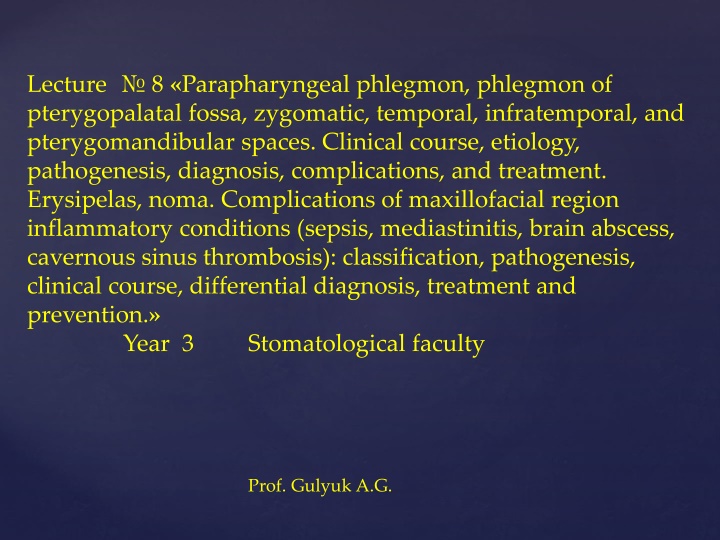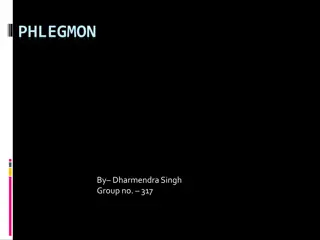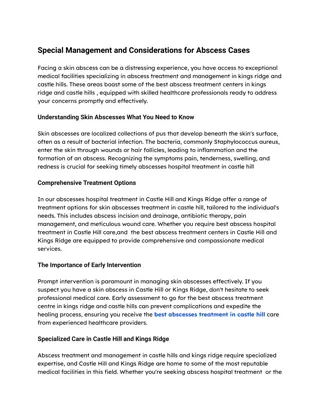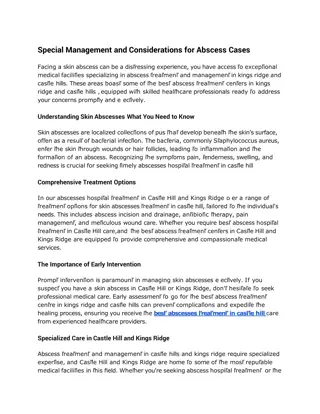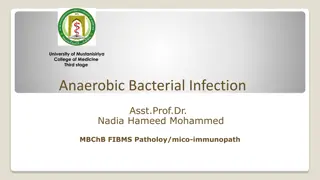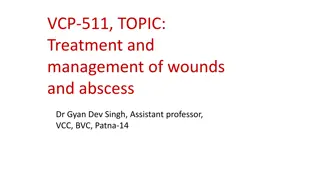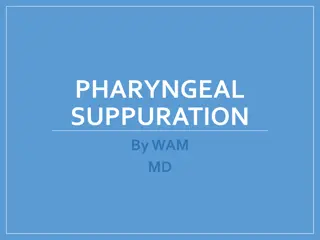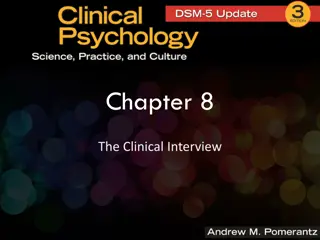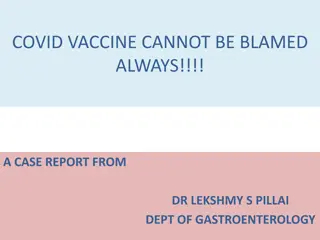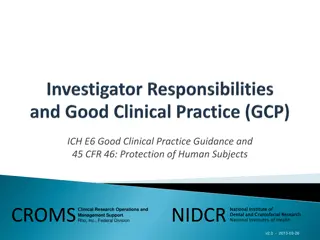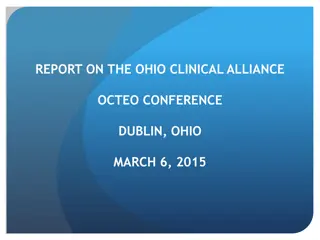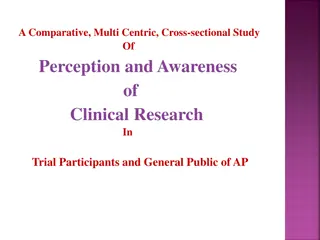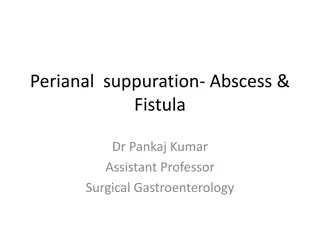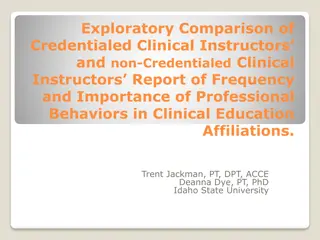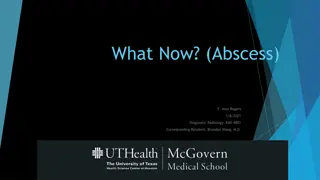Parapharyngeal Phlegmon and Abscess: Clinical Insights
Learn about parapharyngeal phlegmon and abscess, including etiology, complications, treatment, and more. Understand the significance of these conditions in the maxillofacial region inflammatory processes.
Uploaded on Mar 04, 2025 | 0 Views
Download Presentation

Please find below an Image/Link to download the presentation.
The content on the website is provided AS IS for your information and personal use only. It may not be sold, licensed, or shared on other websites without obtaining consent from the author.If you encounter any issues during the download, it is possible that the publisher has removed the file from their server.
You are allowed to download the files provided on this website for personal or commercial use, subject to the condition that they are used lawfully. All files are the property of their respective owners.
The content on the website is provided AS IS for your information and personal use only. It may not be sold, licensed, or shared on other websites without obtaining consent from the author.
E N D
Presentation Transcript
Lecture 8 Parapharyngeal phlegmon, phlegmon of pterygopalatal fossa, zygomatic, temporal, infratemporal, and pterygomandibular spaces. Clinical course, etiology, pathogenesis, diagnosis, complications, and treatment. Erysipelas, noma. Complications of maxillofacial region inflammatory conditions (sepsis, mediastinitis, brain abscess, cavernous sinus thrombosis): classification, pathogenesis, clinical course, differential diagnosis, treatment and prevention. Year 3 Stomatological faculty Prof. Gulyuk A.G.
Abscess is the limited purulent dissolution of the tissues. The hypoderm in well expressed in children in MFA. It has protective ammortisative functions, makes round counters of the face. But due to lack of the blood supply this hypoderm is involved into the inflammatory processes very often. As a result the cavity is formed and is filled in with the pus.
Phlegmon is spreaded purulent dissolution of the soft tissues. This condition is an acute, diffuse inflammatory infiltration of the loose connective tissue found underneath the skin. It is believed today that cellulitis and phlegmon are interchangeable terms. The term cellulitis has prevailed and so the term phlegmon has just about been abandoned.
Etiology: causative agent of abscesses and phlegmons are mixed microflora with dominating of Streptococcus and Staphylococcus in combination with Escherichia coli and other kinds of bacillus.
Parapharyngeal abscesses are a rare complication of acute inflammation of the lymphoid tissue of the throat, the tonsils, the parotid gland, the paranasal sinuses and of the middle ear.
The boundaries of the parapharyngeal space are the lateral pharyngeal wall medially and anteriorly, the medial pterygoid muscle and the parotid gland laterally, and the prevertebral fascia posteriorly. It extends from the base of the skull to the hyoid bone and encompasses the internal carotid, the internal jugular, nerves IX, X, XII, and the cervical sympathetic trunk.
Since the area is surrounded by muscle and fasciae from all sides, the inflammatory processes do not usually manifest outside. They can therefore cause life-threatening complications: mediastinitis and meningitis. The treatment of choice is an incision and intraoral or extraoral drainage of the parapharyngeal space and intensive target intravenous antibiotic therapy
The treatment of choice of abscesses in the parapharyngeal space in adults is surgery with intravenous administration of antibiotics. All the patients hospitalised in the Clinic were treated conservatively with combined antibiotic therapy with careful monitoring for a possible progression of the condition. All the patients were completely cured and no complications (breathing dysfunction or progression of changes towards the mediastinum) were observed.
1. Abscess of the parapharyngeal space can be a complication of pharyngitis in children. 2. When no life-threatening symptoms (breathing dysfunction, mediastinitis) are present, conservative treatment with antibiotics may be administered. 3. If the general condition improves, body temperature returns to normal and the inflammatory parameters lower within 24- 48 h, exclusively conservative treatment may be continued.
4. On the 6th-7th day of treatment a significant decrease in the fluid space of the abscess was observed in the ultrasound. 5. Ultrasound is more efficient at distinguishing an inflammatory infiltration and necrotic tissues from purulent matter than other imaging tests. 6. The patients were hospitalised until the inflammatory parameters returned to normal and the symptoms of the abscess in the ultrasound subsided. The subsequent antibiotic therapy lasted up to 3 weeks.
Retropharyngeal Abscess Anatomic Location. The retropharyngeal space is located posterior to the soft tissue of the osterior wall of the pharynx and is bounded anteriorly by the superior pharyngeal constrictor muscle and the associated fascia, posteriorly by the prevertebral fascia, superiorly by the base of the skull, and inferiorly by the posterior mediastinum.
Etiology. Infections of this space originate in the lateral pharyngeal space, which is close by.
Clinical Presentation. The same symptoms as those present in the lateral pharyngeal abscess appear clinically, with even greater difficulty in swallowing though, due to edema at the posterior wall of the pharynx. If it is not treated in time, there is arisk of: -Obstruction of the upper respiratory tract, due to displacement of the posterior wall of the pharynx anteriorly. -Rupture of the abscess and aspiration of pus into the lungs, with asphyxiation resulting. -Spread of infection into the mediastinum.
Treatment. Therapy entails drainage through the lateral pharyngeal space, which is where the infection usually begins. Administration of antibiotics is mandatory.
Temporal Abscess Anatomic Location. The temporal space is the superior continuation of the infratemporal space. This space is divided into superficial and deep temporal spaces. The superficial temporal space is bounded laterally by the temporal fascia andmedially by the temporalismuscle, while the deep temporal space is found between the medial surface of the temporalis muscle and the temporal bone.
Etiology. Infection of the temporal space is caused by the spread of infection from the infratemporal space, withwhich it communicates.
Clinical Presentation. It is characterized by painful edema of the temporal fascia, trismus (the temporalis and medial pterygoid muscles are involved), and pain during palpation of the edema.
Treatment. The incision for drainage is performed horizontally, at the margin of the scalp hair and approximateli 3 cm above the zygomatic arch. It then continues carefully between the two layers of the temporal fascia as far as the temporalis muscle. A curve hemostat is used to drain the abscess.
Anatomic Location. The space in which this abscess develops is the superior extension of the pterygomandibular space. Laterally, this space is bounded by the ramus of the mandible and the temporalis muscle, while medially, it is bounded by themedial and lateral pterygoid muscles, and is continuous with the temporal fossa.Important anatomic structures, such as the mandibular nerve, mylohyoid nerve, lingual nerve, buccal nerve, chorda tympani nerve, and the maxillary artery, are found in this space. Part of the pterygoid venous plexus is also found inside this space.
Etiology. Infections of the infratemporal space may be caused by infected root canals of posterior teeth of the maxilla and mandible, by way of the pterygomandibular space, andmay also be the result of a posterior superior alveolar nerve block and an inferior alveolar nerve block.
Clinical Presentation. Trismus and pain during opening of the mouth with lateral deviation towards the affected side, edema at the region anterior to the ear which extends above the zygomatic arch, as well as edema of the eyelids are observed.
Treatment. The incision for drainage of the abscess is made intraorally, at the depth of the mucobuccal fold, and, more specifically, laterally (buccally) to the maxillary third molar and medially to the coronoid process, in a superoposterior direction. A hemostat is inserted into the suppurated space, in a superior direction. Drainage of the abscess may be performed extraorally in certain cases.
The incision is performed on the skin in a superior direction, approximately 3 cm. The starting point of the incision is the angle created by the junction of the frontal processes of the zygomatic bone. Drainage of the abscess is achieved with a curved hemostat, which is inserted through the skin into the purulent accumulation. and extends and temporal
Anatomic Location. This space is bounded laterally by the medial surface of the ramus of the mandible, medially by the medial pterygoid muscle, superiorly by the lateral pterygoid muscle, anteriorly by the pterygomandibular raphe, and posteriorly by the parotid gland.
The pterygomandibular space contains the mandibular neurovascular bundle, lingual nerve, and part of the buccal fat pad. It communicates with the pterygopalatal, infratemporal, submandibular, and lateral pharyngeal spaces.
Etiology. An abscess of this space is causedmainly by infection of mandibular third molars or the result of an inferior alveolar nerve block, if the penetration site of the needle is infected (pericoronitis).
Clinical Presentation. Severe trismus and slight extraoral edema beneath the angle of the mandible are observed. Intraorally, edema of the soft palate of the affected side is present, as is displacement of the uvula and lateral pharyngealwall, while there is difficulty in swallowing.
Treatment. The incision for drainage is performed on the mucosa of the oral cavity and,more specifically, along the mesial temporal crest. The incision must be 1.5 cm long and 3 4 mm deep. A curved hemostat is then inserted, which proceeds posteriorly and laterally until it comes into contact with the medial surface of the ramus. The abscess is drained, permitting the evacuation of pus along the shaft of the instrument.
Is an acute infection typically with a skin rash, usually on any of the legs and toes, face, arms and fingers, and in medical terms an infection of the upper dermis and superficial lymphatics, usually caused by streptococcus bacteria on scratches or otherwise infected areas. Erysipelas is more superficial than cellulitis, and is typically more raised and demarcated.
Signs and symptoms Patients typically develop symptoms including high fevers, shaking, chills, fatigue, headaches, vomiting, and general illness within 48 hours of the initial infection. The erythematous skin lesion enlarges rapidly and has a sharply demarcated raised edge.
It appears as a red, swollen, warm, hardened and painful rash, similar in consistency to an orange peel. More severe infections can result in vesicles (pox or insect bite-like marks), bullae (blisters), and petechiae (small purple or red spots), with possible skin necrosis (skin death). Lymph nodes may be swollen, and lymphedema may occur. Occasionally, a red streak extending to the lymph node can be seen.
